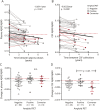High-precision plasma β-amyloid 42/40 predicts current and future brain amyloidosis
- PMID: 31371569
- PMCID: PMC6946467
- DOI: 10.1212/WNL.0000000000008081
High-precision plasma β-amyloid 42/40 predicts current and future brain amyloidosis
Abstract
Objective: We examined whether plasma β-amyloid (Aβ)42/Aβ40, as measured by a high-precision assay, accurately diagnosed brain amyloidosis using amyloid PET or CSF p-tau181/Aβ42 as reference standards.
Methods: Using an immunoprecipitation and liquid chromatography-mass spectrometry assay, we measured Aβ42/Aβ40 in plasma and CSF samples from 158 mostly cognitively normal individuals that were collected within 18 months of an amyloid PET scan.
Results: Plasma Aβ42/Aβ40 had a high correspondence with amyloid PET status (receiver operating characteristic area under the curve [AUC] 0.88, 95% confidence interval [CI] 0.82-0.93) and CSF p-tau181/Aβ42 (AUC 0.85, 95% CI 0.79-0.92). The combination of plasma Aβ42/Aβ40, age, and APOE ε4 status had a very high correspondence with amyloid PET (AUC 0.94, 95% CI 0.90-0.97). Individuals with a negative amyloid PET scan at baseline and a positive plasma Aβ42/Aβ40 (<0.1218) had a 15-fold greater risk of conversion to amyloid PET-positive compared to individuals with a negative plasma Aβ42/Aβ40 (p = 0.01).
Conclusions: Plasma Aβ42/Aβ40, especially when combined with age and APOE ε4 status, accurately diagnoses brain amyloidosis and can be used to screen cognitively normal individuals for brain amyloidosis. Individuals with a negative amyloid PET scan and positive plasma Aβ42/Aβ40 are at increased risk for converting to amyloid PET-positive. Plasma Aβ42/Aβ40 could be used in prevention trials to screen for individuals likely to be amyloid PET-positive and at risk for Alzheimer disease dementia.
Classification of evidence: This study provides Class II evidence that plasma Aβ42/Aβ40 levels accurately determine amyloid PET status in cognitively normal research participants.
© 2019 American Academy of Neurology.
Figures




Comment in
-
Screening with a high-precision blood-based assay for Alzheimer disease.Neurology. 2019 Oct 22;93(17):737-738. doi: 10.1212/WNL.0000000000008080. Epub 2019 Aug 1. Neurology. 2019. PMID: 31371570 No abstract available.
References
Publication types
MeSH terms
Substances
Grants and funding
LinkOut - more resources
Full Text Sources
Other Literature Sources
Medical
Research Materials
Miscellaneous
